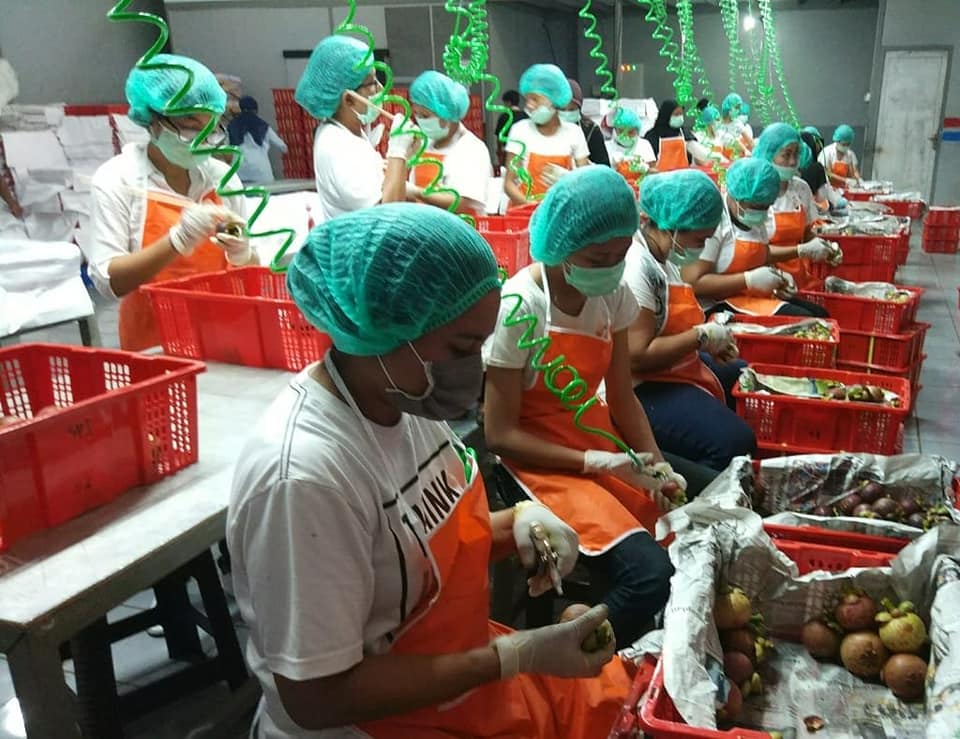Indonesia is renowned as one of the top producers of mangosteen in the world. This tropical fruit, known for its sweet taste, soft flesh, and numerous health benefits, has gained increasing demand in international markets such as China, the United Arab Emirates, and Europe. To successfully deliver fresh mangosteen to these markets, proper handling from harvest to shipping is essential. In this article, we will explore the steps necessary to ensure mangosteen arrives in prime condition for export.
1. Harvesting Mangosteen to Meet Export Standards
Maintaining the quality of mangosteen begins with proper harvesting practices. Here’s what to consider:
- Optimal Harvest Time: Mangosteen intended for export should be harvested 104–108 days after flowering, when the skin turns reddish-purple. Early or late harvesting can impact the taste and shelf life of the fruit.
- Harvesting Method: Use gentle techniques to avoid damaging the fruit. Hand-picking or tools like pruning shears are ideal to preserve the integrity of the mangosteen skin. Avoid direct cuts that may cause blemishes or injuries.
Proper harvesting minimizes physical damage and ensures only export-quality fruit is selected.
2. Careful Selection and Sorting
After harvesting, a rigorous selection process is key to exporting only the best mangosteens:
- Size Grading: Sort mangosteens by size, as uniformity in size enhances market appeal.
- Skin Condition: Select fruit with smooth, unblemished skin free from scratches or excess sap.
- Flesh Quality: If possible, conduct random sampling to ensure the flesh is free from defects like yellow segments.
By prioritizing careful sorting, exporters can enhance the consistency and perceived quality of their products.
3. Gentle Cleaning Methods
Cleaning mangosteen is essential to maintain its visual appeal without compromising its quality:
- Cleaning Technique: Use a soft, damp cloth to remove dirt and debris from the surface.
- Avoid Excessive Moisture: Do not wash the fruit directly with running water, as excess moisture can accelerate spoilage.
A clean and well-presented mangosteen not only looks appealing but also increases buyer confidence.
4. Packaging for Maximum Protection
Packaging plays a crucial role in protecting mangosteen during transit. Consider these tips:
- Packaging Materials: Use ventilated plastic crates or cardboard boxes that allow air circulation to prevent heat buildup.
- Protective Layers: Line the boxes with soft materials like paper or foam to cushion the fruit and prevent bruising.
- Grouping by Size: Arrange fruit by size within each package for a more professional presentation.
Effective packaging minimizes damage and ensures the fruit arrives in excellent condition.
5. Storage Under Controlled Conditions
Before shipping, proper storage is critical for maintaining the freshness of mangosteen:
- Temperature Management: Store mangosteen at a temperature of 5–10°C to extend shelf life without causing chilling injury.
- Humidity Levels: Maintain high humidity (90–95%) in storage areas to prevent the skin from drying out.
Controlled storage conditions are essential for preserving the fruit’s freshness during the export process.
6. Transport in Refrigerated Containers
Refrigerated transport (cold storage) is the best solution for delivering mangosteen to international markets:
- Refrigerated Containers: Utilize containers with adjustable temperature settings to maintain a stable environment during transit.
- Careful Handling: Minimize shocks and pressure on the fruit during transport to prevent physical damage.
Properly managed logistics ensure the fruit’s quality is upheld, even during long journeys.
7. Documentation for Export Compliance
Accurate documentation is essential for smooth export processes:
- Phytosanitary Certificate: Ensure the shipment is certified free of pests and diseases.
- Certificate of Origin: Provide proof of the product’s origin.
- Additional Certifications: Certifications like Global GAP or Organic Certification can enhance market value and appeal.
Well-organized documentation speeds up customs clearance and enhances the buyer’s trust.
8. Adherence to International Standards
To penetrate international markets, mangosteen must meet specific quality standards. For example:
- European Union Standards: Ensure compliance with regulations regarding maximum pesticide residue levels (MRLs).
- Chinese Standards: Fulfill buyer requirements for size, skin color, and moisture levels.
By adhering to these standards, exporters can secure and maintain access to lucrative markets.
9. Monitoring and Continuous Improvement
Even after the shipment is delivered, continuous monitoring and improvement are necessary to enhance the export process:
- Customer Feedback: Collect feedback from buyers to assess satisfaction with product quality.
- Logistics Evaluation: Review the performance of logistics arrangements to identify areas for optimization.
Constant evaluation ensures long-term success in the competitive export market.
Conclusion
Exporting mangosteen requires meticulous handling at every stage, from harvesting to shipping. By focusing on key aspects such as proper harvesting methods, stringent sorting, effective packaging, controlled storage, and adherence to international standards, exporters can deliver fresh, high-quality mangosteen to global markets.
Not only does proper handling maintain the fruit’s value, but it also reinforces Indonesia’s reputation as a producer of premium tropical fruits. As demand for mangosteen continues to grow, a commitment to quality and excellence will be the foundation for long-term success in the export industry.
